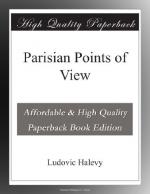The following morning Mme. Derline found ten lines on the Palmer’s ball in the “society column.” There was mention of the marquises, the countesses, and the duchesses who were there, but about Mme. Derline there was not a word—not a word.
On the other hand, the writer of theatrical gossip celebrated in enthusiastic terms the beauty of that ideal maid-of-honor, and said, “Besides, the Prince of Nerins declared that Mademoiselle Miranda was indisputedly the most beautiful woman in Paris!”
Mme. Derline threw the paper in the fire. She did not wish her husband to know that she was already not the most beautiful woman in Paris.
She has, however, kept the great dress-maker and the English coachman, but she never dared to ask for the little groom.
THE STORY OF A BALL-DRESS
When the women of the seventeenth and eighteenth centuries write their memoirs they boldly present themselves to the reader thus: “I have a well-shaped mouth,” said the Marquise of Courcelles, “beautiful lips, pearly teeth, good forehead, cheeks, and expression, finely chiselled throat, divine hands, passable arms (that is to say, they are a little thin); but I find consolation for that misfortune in the fact that I have the prettiest legs in the world.”
And I will follow the marquise’s example. Here is my portrait: Overskirt of white illusion trimmed with fringe, and three flounces of blond alternating with the fringe; court mantle of cherry silk girt by a high flounce of white blond which falls over the fringe and is caught up by Marie Antoinette satin; two other flounces of blond are placed behind at intervals above; on each side from the waist up are facings composed of little alternating flounces of blond, looped up with satin; the big puff behind is bound by a flounce of white blond. A little white waist, the front and shoulder-straps of which are of satin trimmed with blond. Belt of red satin with large red butterfly.
The world was made in six days, I in three. And yet I too am in the world—a little complicated world of silk, satin, blond, loops, and fringes. Did God rest while he was making the world? I do not know; but I do know that the scissors that cut me out and the needle that sewed me rested neither day nor night from Monday evening, January 24, 1870, to Thursday morning, January 27th. The slashes of the scissors and the pricks of the needle caused me great pain at first, but I soon paid no attention to them at all. I began to observe what was going on, to understand that I was becoming a dress, and to discover that the dress would be a marvel. From time to time M. Worth came himself to pay me little visits. “Take in the waist,” he would say, “add more fringe, spread out the train, enlarge the butterfly,” etc.
One thing worried me: For whom was I intended? I knew the name, nothing more—the Baroness Z——. Princess would have been better; but still, baroness did very well. I was ambitious. I dreaded the theatre. It remained to be seen whether this baroness was young, pretty, and equal to wearing me boldly, and whether she had a figure to show me off to advantage. I was horribly afraid of falling into the hands of an ugly woman, a provincial, or an old coquette.




